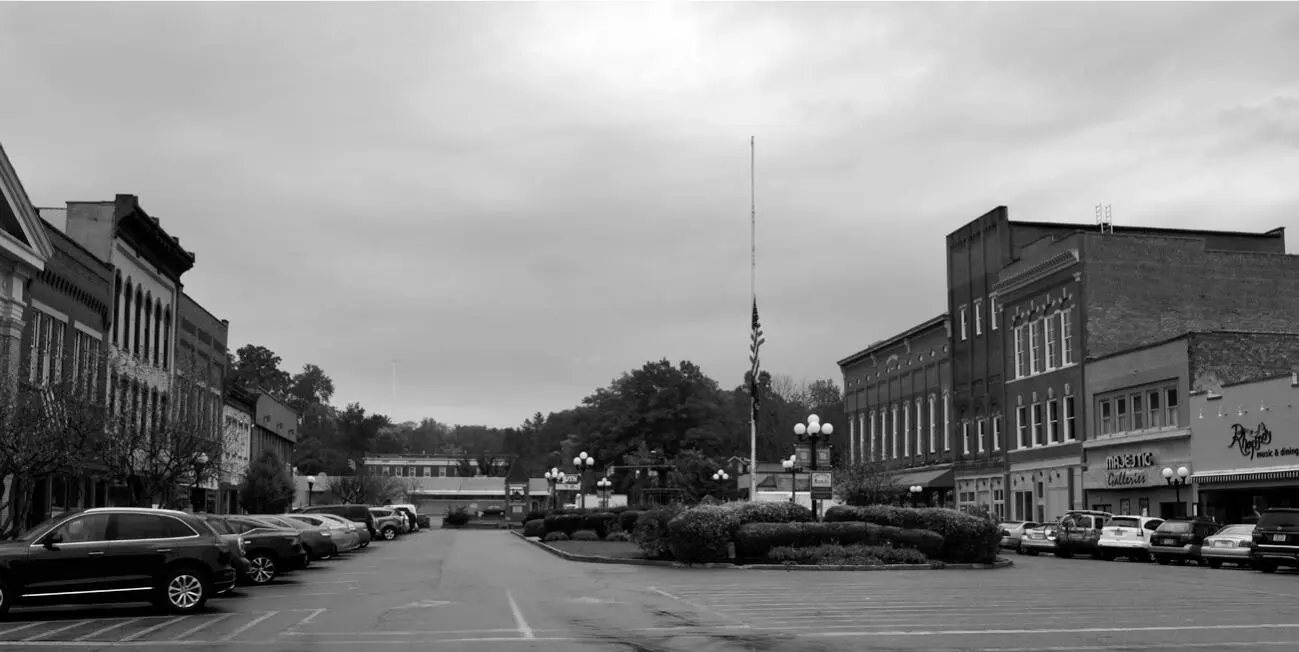1 ...8 9 10 12 13 14 ...21 
With ARC support, Nelsonville, Ohio, is working to renovate and rebuild an historic town square in which they can host cultural activities for the communities in Athens County.
Just twenty minutes up the road from Athens is the second largest city in Athens County, Nelsonville, home to 5,300 people. There I find an emerging arts community thanks to revitalization projects funded by the Appalachian Regional Commission. Although the ARC is slated to be defunded by the federal government, its contributions to this community are clear. With ARC funding the gorgeous old opera house on the town square is being refurbished to serve as an arts and music center for the community. And, thanks to ARC cash infusions and an industrious core of volunteer residents, the town hosts car shows and a smoked meat festival that draw people from around the county.
Nelsonville is home to Hocking College, a small, two-year technical college with majors in areas such as equine studies, nursing, construction, and food service. The college adds about 2,100 students to the local population. As in Athens, and other college towns across the country, landlords here push rents higher by renting houses by the bedroom to college students. If Ohio University in Athens has not been able to shake a reputation for drugs and alcohol, Hocking has not been able to shake a reputation for scandal generated by sexual assaults, race-based hate crimes, and administrative mismanagement. Athens and Nelsonville are the largest towns in the county, which also includes eight small villages salted across 508 square miles. 5
Michael Chase lives in Athens County and is working two part-time service industry jobs when we meet. With one white parent and one Black, Michael characterizes himself as American Black, “because when I say I’m Black, people ask me if I’m Ethiopian, so I’ll just say American Black.” Michael grew up in the area and has a high school degree. At age twenty-one, he is part of a generation that turns to the internet for news, social media, and impressive amounts of random trivia – like the history of straws. He is clearly a smart and engaged person, but college was never part of the plan for Michael. In his senior year, when he had his first conversations about college with friends, he realized he wanted to go, but he didn’t know what he wanted to study. Some families spend thousands of dollars on college prep courses, others spend tens of thousands of dollars on college-counseling services, and still others expect their child to walk in the front door of an elite university as a “legacy” acceptance. There was none of this for Michael. No one seemed to have college in mind for him. Not his parents, not his teachers, and not the school guidance counselors. His future seemed to end with high school. Now Michael is more aware of the hazards he faces in life than of the opportunities he might have as a college student. “I’ll say for right now, I’m only twenty-one. I don’t have kids. I’m not in jail or prison. I’m not out here doing drugs or drunk driving or anything. I like to just work, hang out with friends. As for my future, I don’t know.”
Michael currently works a night shift at the front desk of hotel and a day shift at a nonprofit – both jobs are in the city of Athens. He thinks of himself as fortunate because although his work schedules vary each week, his hours never conflict. Neither job guarantees Michael a set number of hours or specific days. He might work weekends or weekdays – he discovers his days and hours each week when the schedules are posted. Since he never knows how many hours will be available to him in the future, he scrambles for all the time he can get. This means that on some days he works an eight-hour shift at each job. It also means he can go for days without working at all. There is no economic security, even though these are permanent positions. The constant variability of his work hours also makes it difficult if not impossible for him to schedule any personal appointments in advance.
Between his two jobs, Michael earns less than $16,000 a year; he doesn’t have health insurance, sick leave, or vacation time. He shares an apartment with three other people – a situation he finds stressful – and still he worries at times about making his rent. When he works back-to-back eight-hour shifts for some length of time, Michael has been able to save as much as $500, which he tells me makes him feel quite rich. It also exhausts him. Days later he is still catching up on sleep. Despite his high energy and easy laughter, the dark circles under his eyes give away the pressure he is under. Almost everyone I meet in Southeast Ohio works multiple service industry jobs. In the area, it is common practice in the service industry to hire part-time workers. Locals believe this is intentional. It saves the companies a lot of money when they leave workers without sick time, health care, vacation time, or a retirement plan.
When I asked Michael how he would identify himself by socio-economic class, he said: “I would say for myself, I don’t know, I’m fine. … I don’t consider myself poor. I would say … I guess I would say I am struggling a little bit. I’m fine, I have all my stuff paid, I’m just not in a higher tax bracket. I guess I’m poor but I’m not – for me people who don’t have food are poor. Or, someone who can’t feed their kids, or you might not have running water or even electricity. I would say poor is when you just don’t got anything. I think if you’re poor, you don’t have the right things you need to even survive.”
The reality in Southeast Ohio is that everyone seems to know folks who are in far worse circumstances. For Michael and others, “being poor” means living in homes without running water or electricity or being unable to feed their children. A surprising number of Michael’s neighbors live in exactly this condition. In 2017, Athens County had the highest rate of food insecurity in the state of Ohio. Almost 27% of children in the county lack consistent access to adequate food and about 70% of residents hover around the federal poverty line. 6This sounds stark, and it is. In these circumstances, working families skip meals and/or reduce the size of meals, and/or rotate who gets to eat a meal, in order to make their food last.
Community food banks, once an emergency resource during difficult times, have become a weekly resource for families. As for access to running water, in 2014, when the US Census stopped collecting data on the number of households without running water, 1,000 homes in Athens County (1.5% of the population) lacked full indoor plumbing, while in neighboring Meigs County another 400 homes (1.7% of the population) had no running water. 7Given this context, it might be clear why Michael does not think of himself as poor. The more serious issue is that the federal government does not think of him as poor either. The federal poverty line in 2017 for an individual was $12,060. In that year, 17.6% of African Americans fell at or below the federal poverty line. As you notice, Michael does not.
By working two jobs, Michael earns something below $16,000. He does not have stable work, lives paycheck to paycheck, and struggles to pay the rent on a shared flat. Yet the federal government does not count him among the nation’s poor. This is exactly why it is important to understand the distinction between the federal poverty line and a self-sufficiency income. The Economic Policy Institute self-sufficiency budget puts Michael’s experience in a very different context. As we saw in Chapter 1, the EPI self-sufficiency budget is based on basic monthly expenses in each region of the country. For a single person in Athens County, the budget is $34,545.
Читать дальше













